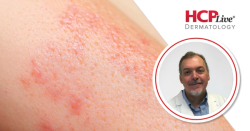
OR WAIT null SECS
Upadacitinib Effective for Disease Clearance, Itch in Older Adults with Atopic Dermatitis
These data from RAD 2025 highlight upadacitinib’s efficacy in the phase 3 Measure Up 1 and 2 studies for older adults with atopic dermatitis.
Older adults with atopic dermatitis aged ≥ 65 years who are treated with oral upadacitinib 15 mg as a once-daily monotherapy may attain optimal skin clearance and relief from itch, new findings suggest, along with notable quality of life and sleep improvements.1
These findings were released as late-breaking data at the 2025 Revolutionizing Atopic Dermatitis (RAD) Conference in Nashville, Tennessee. The poster was titled "Achieving Optimal Treatment Targets for Skin Clearance and Itch Relief in Older Adults (≥65 Years) with Moderate-to-Severe Atopic Dermatitis Treated with Upadacitinib Monotherapy: 140-Week Outcomes from Integrated Phase 3 Measure Up 1 and 2 Studies."
A team of investigators authored the phase 3 Measure Up studies, including Christopher G. Bunick, MD, PhD, associate professor of dermatology at Yale School of Medicine. Bunick and colleagues noted in the Measure Up poster’s background section that unique challenges are faced among older adults living with atopic dermatitis, given age-related shifts in skin barrier function and given immune system alterations that result from the skin disease.
This analysis, which drew on data from the Measure Up 1 (NCT03569293) and Measure Up 2 (NCT03607422) trials, looked at 15 mg daily use of upadacitinib as a monotherapy in those aged 65 years and older with moderate-to-severe atopic dermatitis.1 The US Food and Drug Administration (FDA) approved upadacitinib's use in atopic dermatitis for patients 12 years of age and older in 2022.2
In Bunick et al’s new post-hoc pooled analysis, participants in the aforementioned age range were randomly assigned to be treated either with oral upadacitinib 15 mg or a placebo each day for a total of 16 weeks, with investigators implementing a double-blinded design. For trial subjects who continued into the long-term extension phase of the study, these individuals would remain on blinded 15 mg upadacitinib therapy through the 140-week mark.
The investigative team assessed the medication’s efficacy via clinical endpoints aligned with the AHEAD (Aiming High in Eczema/Atopic Dermatitis) initiative. They highlighted physician- and patient-reported outcomes among the trial subjects.
The team’s clinical goals included attainment of minimal pruritus symptoms (Worst Pruritus Numeric Rating Scale [WP-NRS] score of 0 or 1), at least a 90% improvement in participants’ Eczema Area and Severity Index (EASI 90) scores, and a lack of reported impacts on quality of life (Dermatology Life Quality Index [DLQI] of 0 or 1). They also looked into such endpoints as Minimal Disease Activity, which was defined as meeting both EASI 90 and WP-NRS 0/1 simultaneously, and they assessed whether patients had a ≥12-point reduction in their sleep disturbance related to disease (ΔADerm-IS Sleep ≥12).
Bunick and colleagues looked into rates of response via non-responder imputation through the 16-week mark and observed case analysis through the 140-week mark. They assessed adverse events of special interest (AESIs) over both of these timeframes. The investigative team noted that by Week 16, 50.0% of those involved who were receiving upadacitinib attained an EASI 90 score, and 42.9% attained WP-NRS 0/1.1
They further highlighted that 32.1% met the criteria for Minimal Disease Activity. Additionally, the team found that 42.3% reported DLQI 0/1, and 57.1% reported having clinically meaningful changes in their levels of sleep disturbance (ΔADerm-IS Sleep ≥12).
In comparison, none of those in the placebo arm succeeded in achieving either WP-NRS 0/1 or MDA by the 16-week mark. Only 13.6% of these subjects reported DLQI 0/1, 18.2% attained EASI 90, and 11.8% noted having sleep improvements that met the study’s ≥12-point threshold. By the 140-week mark, long-term outcomes remained favorable among patients continuing upadacitinib (n=15): 80.0% achieved EASI 90, 73.3% reported WP-NRS 0/1, 60.0% met MDA, 64.3% had DLQI 0/1, and 81.8% demonstrated a ΔADerm-IS Sleep score of ≥12.
The investigators’ evaluation of upadacitinib’s safety led to the conclusion that exposure-adjusted event rates across 88.3 patient-years remained low through the 140-week mark.1 These rates were as follows: 1.1 serious infections per 100 patient-years (E/100PY), 4.5 herpes zoster events per 100 PY, 1.1 malignancies (excluding non-melanoma skin cancer) per 100 PY, and 3.5 major adverse cardiovascular events (n/100PY).
One notable finding Bunick and coauthors reported was a lack of reported cases of thromboembolic events, opportunistic infections, or gastrointestinal perforations. None of the AESIs that did take place occurred within the initial 16-week period of treatment. Overall, patients aged ≥65 years treated with once-daily oral upadacitinib 15 mg achieved both optimal levels of atopic dermatitis clearance and itch relief, along with quality of life and sleep improvements.
“Most maintained higher response rates through Week 140,” the investigative team concluded.1 “Upadacitinib was well tolerated, with no new important safety concerns identified, underscoring its utility as a treatment option for moderate-to-severe atopic dermatitis in this population.”
References
Bunick C, Butler D, Dasilva D, et al. Achieving Optimal Treatment Targets for Skin Clearance and Itch Relief in Older Adults (≥65 Years) with Moderate-to-Severe Atopic Dermatitis Treated with Upadacitinib Monotherapy: 140-Week Outcomes from Integrated Phase 3 Measure Up 1 and 2 Studies. Poster presented at: 2025 Revolutionizing Atopic Dermatitis Conference; June 6-7, 2025; Nashville, TN.
Butera A. FDA Approves Upadacitinib for Patients 12 Years and Older with Moderate to Severe Atopic Dermatitis. HCPLive. January 14, 2022. Accessed June 20, 2025. https://www.hcplive.com/view/fda-upadacitinib-children-atopic-dermatitis.


